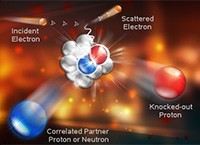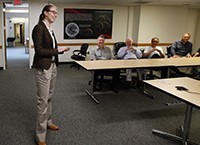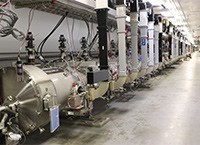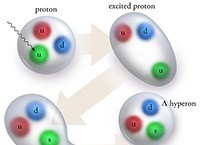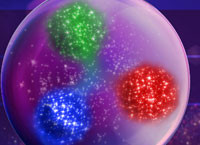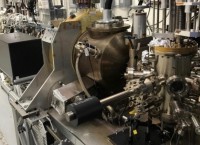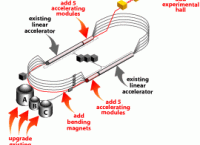Science
Additional Links
Thomas Jefferson National Accelerator Facility is a U.S. Department of Energy Office of Science national laboratory. Jefferson Lab's unique and exciting mission is to expand our knowledge of the universe by studying the basic building blocks of matter within the nucleus: subatomic particles known as quarks and gluons.
To learn how these particles build our universe, we have embarked on a journey of discovery into the heart of matter using the Continuous Electron Beam Accelerator Facility (shown above). CEBAF is the world's most advanced particle accelerator for investigating the quark structure of the atom's nucleus. Learn more about nuclear physics at Jefferson Lab in Exploring Matter.
For more in-depth and technical information, see the links below.
From the stars overhead to the atoms in our own DNA, all matter is composed of fundamental particles — particles that cannot be divided into smaller parts. Quarks, we believe, are among the few fundamental particles in the universe. These particles combine to form the protons and neutrons found in the nucleus of the atom. Here at Jefferson Lab, we study the world subatomic to learn how ordinary matter is comprised. Click the link to learn more about the research carried out by nuclear physicists at Jefferson Lab.
The Center for Theoretical and Computational Physics pursues a broad program of theoretical research to promote and support the experimental nuclear physics carried out at Jefferson Lab and related facilities around the world. Click the link to learn more.
To study the very small, scientists need a very large microscope. The Continuous Electron Beam Accelerator Facility (CEBAF) is the lab’s particle accelerator, and it is the world's most advanced particle accelerator for investigating the quark structure of the atom's nucleus. Click the link to learn more about CEBAF and the world-leading accelerator science program that enables it.
What have we learned through the research we've carried out? Click here to read about the latest research results.
Jefferson Lab, in association with Brookhaven National Lab and the DOE Office of Nuclear Physics, has restarted a generic detector R&D program to address the scientific requirements for measurements at the future Electron Ion Collider.
The Laboratory Directed Research and Development (LDRD) program enables the lab to respond to timely scientific and technological opportunities that also support DOE’s research and development mission. This program is a critical tool for directing the lab's forefront scientific research capabilities towards vital, excellent and emerging scientific challenges. Read more about the program here.
Officially completed in September 2017, the 12 GeV Upgrade Project of the Continuous Electron Beam Accelerator Facility (CEBAF) at Jefferson Lab heralds a new era to image nuclei at their deepest level. Completed on time and on budget, the $338 million upgrade tripled CEBAF's original operating energy and commissioned a new experimental area dedicated to providing insight into one of the universe’s great mysteries: why the fundamental constituents of matter, quarks, may never be found in isolation. The three existing experimental areas were also upgraded to allow the 3D imaging of the quarks in nuclei and to facilitate unique searches for new physics. Click the link to learn more about the 12 GeV Upgrade and the new journey of discovery it enables.
Multi-Lab Partnerships are valuable because they enable the efficient sharing of resources, fostering collaboration and innovation.
From the stars overhead to the atoms in our own DNA, all matter is composed of fundamental particles — particles that cannot be divided into smaller parts. Quarks, we believe, are among the few fundamental particles in the universe. These particles combine to form the protons and neutrons found in the nucleus of the atom. Here at Jefferson Lab, we study the world subatomic to learn how ordinary matter is comprised. Click the link to learn more about the research carried out by nuclear physicists at Jefferson Lab.
The Center for Theoretical and Computational Physics pursues a broad program of theoretical research to promote and support the experimental nuclear physics carried out at Jefferson Lab and related facilities around the world. Click the link to learn more.
To study the very small, scientists need a very large microscope. The Continuous Electron Beam Accelerator Facility (CEBAF) is the lab’s particle accelerator, and it is the world's most advanced particle accelerator for investigating the quark structure of the atom's nucleus. Click the link to learn more about CEBAF and the world-leading accelerator science program that enables it.
What have we learned through the research we've carried out? Click here to read about the latest research results.
Jefferson Lab, in association with Brookhaven National Lab and the DOE Office of Nuclear Physics, has restarted a generic detector R&D program to address the scientific requirements for measurements at the future Electron Ion Collider.
The Laboratory Directed Research and Development (LDRD) program enables the lab to respond to timely scientific and technological opportunities that also support DOE’s research and development mission. This program is a critical tool for directing the lab's forefront scientific research capabilities towards vital, excellent and emerging scientific challenges. Read more about the program here.
Officially completed in September 2017, the 12 GeV Upgrade Project of the Continuous Electron Beam Accelerator Facility (CEBAF) at Jefferson Lab heralds a new era to image nuclei at their deepest level. Completed on time and on budget, the $338 million upgrade tripled CEBAF's original operating energy and commissioned a new experimental area dedicated to providing insight into one of the universe’s great mysteries: why the fundamental constituents of matter, quarks, may never be found in isolation. The three existing experimental areas were also upgraded to allow the 3D imaging of the quarks in nuclei and to facilitate unique searches for new physics. Click the link to learn more about the 12 GeV Upgrade and the new journey of discovery it enables.
Multi-Lab Partnerships are valuable because they enable the efficient sharing of resources, fostering collaboration and innovation.



